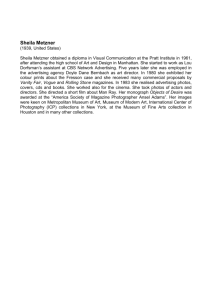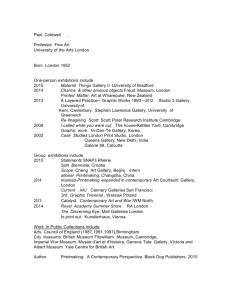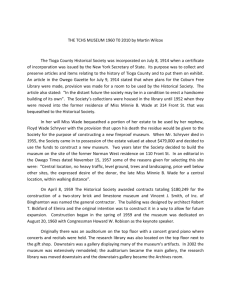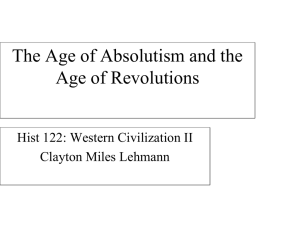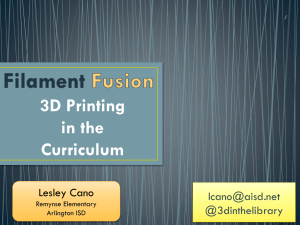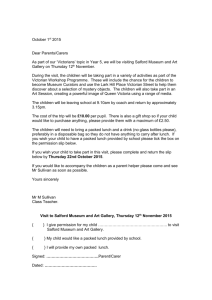Lesson 1
advertisement
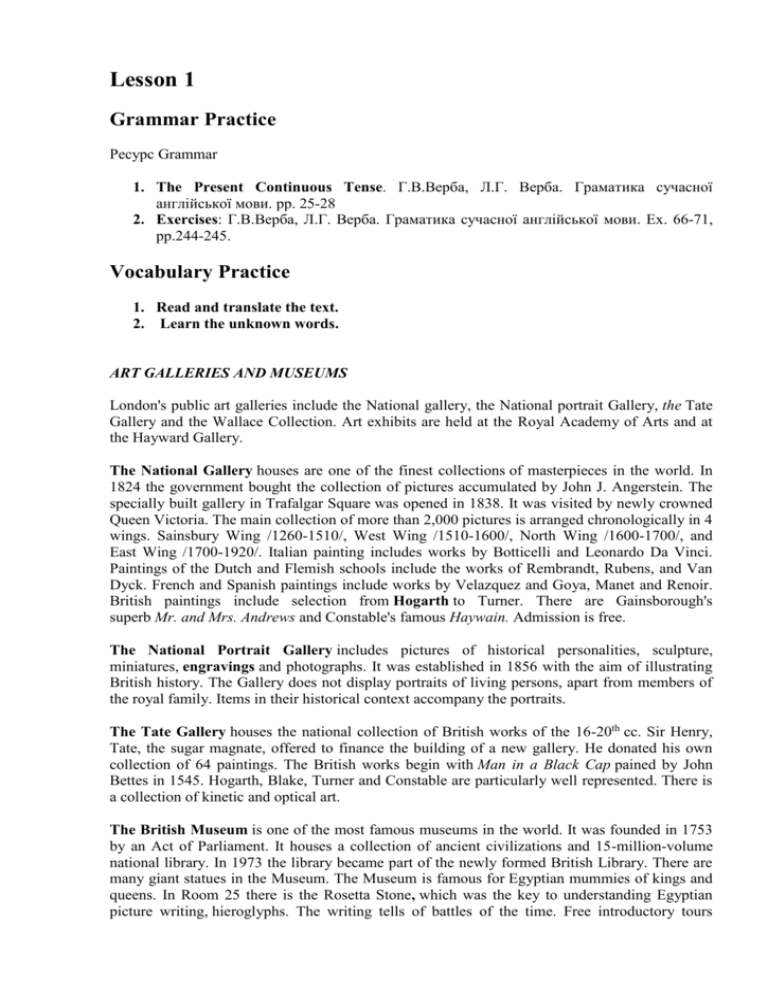
Lesson 1 Grammar Practice Ресурс Grammar 1. The Present Continuous Tense. Г.В.Верба, Л.Г. Верба. Граматика сучасної англійської мови. pp. 25-28 2. Exercises: Г.В.Верба, Л.Г. Верба. Граматика сучасної англійської мови. Ex. 66-71, pp.244-245. Vocabulary Practice 1. Read and translate the text. 2. Learn the unknown words. ART GALLERIES AND MUSEUMS London's public art galleries include the National gallery, the National portrait Gallery, the Tate Gallery and the Wallace Collection. Art exhibits are held at the Royal Academy of Arts and at the Hayward Gallery. The National Gallery houses are one of the finest collections of masterpieces in the world. In 1824 the government bought the collection of pictures accumulated by John J. Angerstein. The specially built gallery in Trafalgar Square was opened in 1838. It was visited by newly crowned Queen Victoria. The main collection of more than 2,000 pictures is arranged chronologically in 4 wings. Sainsbury Wing /1260-1510/, West Wing /1510-1600/, North Wing /1600-1700/, and East Wing /1700-1920/. Italian painting includes works by Botticelli and Leonardo Da Vinci. Paintings of the Dutch and Flemish schools include the works of Rembrandt, Rubens, and Van Dyck. French and Spanish paintings include works by Velazquez and Goya, Manet and Renoir. British paintings include selection from Hogarth to Turner. There are Gainsborough's superb Mr. and Mrs. Andrews and Constable's famous Haywain. Admission is free. The National Portrait Gallery includes pictures of historical personalities, sculpture, miniatures, engravings and photographs. It was established in 1856 with the aim of illustrating British history. The Gallery does not display portraits of living persons, apart from members of the royal family. Items in their historical context accompany the portraits. The Tate Gallery houses the national collection of British works of the 16-20th cc. Sir Henry, Tate, the sugar magnate, offered to finance the building of a new gallery. He donated his own collection of 64 paintings. The British works begin with Man in a Black Cap pained by John Bettes in 1545. Hogarth, Blake, Turner and Constable are particularly well represented. There is a collection of kinetic and optical art. The British Museum is one of the most famous museums in the world. It was founded in 1753 by an Act of Parliament. It houses a collection of ancient civilizations and 15-million-volume national library. In 1973 the library became part of the newly formed British Library. There are many giant statues in the Museum. The Museum is famous for Egyptian mummies of kings and queens. In Room 25 there is the Rosetta Stone, which was the key to understanding Egyptian picture writing, hieroglyphs. The writing tells of battles of the time. Free introductory tours include The World of Asia, Europe, The Ancient Near East, Early Egypt and Nubia, and Treasures of the Islamic World. Admission is free although donations are welcome. The Victoria and Albert Museum / V & A/ has the largest collection of decorative art. The English costumes dating from the 16th century are displayed here. The oldest is a boy's shirt from the 1540's. There are also outstanding landscapes of John Constable and English and Continental sculpture. There is a special collection of tiny miniature portraits. The Great Bed of Ware was made of oak in 1580 is kept at V & A. It is big enough to hold 8 people. The people who slept in it, by tradition carved their names on it. The Louvre, national art museum of France and the palace in which it is housed, located in Paris, on the right bank of the Seine River. The structure, until 1682 a residence of the kings of France, is one of the largest palaces in the world. It occupies the site of a 13th-century fortress. In 1793 the Louvre was opened as a public museum, and the French painter JacquesLouis David was appointed head of a commission to administer it. In 1848 it became the property of the state. The nucleus of the Louvre collections is the group of Italian Renaissance paintings—among them several by Leonardo da Vinci—which were owned by Francis I, a collector and patron of note. Among its greatest treasures are two of the most famous sculptures of the ancient world, the Victory of Samothrace and the Venus de Milo, and Leonardo's famous portrait, Mona Lisa. The Louvre also holds works by the other Italian masters Raphael and Titian and paintings by the northern artists Peter Paul Rubens and Rembrandt. Protection of all the Louvre's priceless masterpieces during the two world wars was effected by their removal to secret depositories outside Paris. The Prado, art museum located in Madrid, Spain. Also called the National Museum of Painting and Sculpture, the Prado houses nearly 3000 paintings and many other sculptures, drawings, and pieces of furniture and decorative art. The collection consists mainly of works added to the Spanish royal collection from the 16th century to the early 19th century. Artists from countries that were friendly with Spain contributed to the royal collection, so many outstanding examples of the Italian and Flemish schools of painting are represented. Of particular note is a series of paintings by Titian commissioned by Charles V and Philip II in the 16th century, and a series painted by Rubens for Philip IV in the early 17th century. In addition, the Prado houses an outstanding collection of paintings from the Spanish school, including works by Goya and El Greco. The Prado was founded in 1810 by King Fernando VII at the initiative of his wife, Doсa Isabel of Braganza. The original building, a great work of neoclassical architecture by the Spanish architect D. Juan de Villanueva, has had several extensions added to it during the 20th century. Today the collection is divided between the Villanueva building, which houses paintings from the Middle Ages to the 19th century, and the Casуn del Buen Retins, which houses 19th century works formerly displayed in the Prado and the Modern Art Museum. State Hermitage Museum, museum of art in Saint Petersburg, Russia. The Hermitage is the largest public museum in Russia and home to one of the greatest art collections in the world. Russian Empress Catherine the Great founded the Hermitage in 1764 as a museum for the royal court. The holdings originally consisted of Western European works of art that she purchased from private collections. These were housed in a private gallery called the Small Hermitage that was connected to the Winter Palace, the vast, ornate winter home of the Russian tzars. The tzars who succeeded Catherine substantially increased the collections, which expanded into the Old Hermitage, another private gallery adjoining the Winter Palace. The buildings comprising the Hermitage were rebuilt after a fire in the Winter Palace in 1837. The museum opened to the public in 1852 and became public property known as the State Hermitage Museum in 1917, following the Russian Revolution. The collections are now housed in five magnificent interconnected buildings, including the Winter Palace. The lavish exteriors and interiors of these buildings are of architectural and historical importance in themselves. They provide a rich setting for collections that cover virtually every aspect of the fine arts, from classical antiquity to 20th-century painting. The collection also includes examples of Russian art, artifacts from non-Western cultures, Oriental art, coins, and jewelry. The Hermitage’s collection of Western European art is particularly strong in Italian, Spanish, Flemish, and Dutch paintings and includes major works by Leonardo da Vinci, Raphael, Giorgione, Caravaggio, El Greco, Rembrandt, and Peter Paul Rubens. The Schukin and Morozov Collections of impressionist, postimpressionist, and modern paintings contain many of the finest works by Henri Matisse, as well as major paintings by Vincent van Gogh, Paul Gauguin, Henri Rousseau, and Pablo Picasso. Metropolitan Museum of Art, art museum in New York City, one of the largest museums in the world. Founded in 1870 by a group of public figures, philanthropists, and artists, the museum has occupied its current location in New York City's Central Park since 1880 in buildings designed by the American architect Richard Morris Hunt. The museum's collections, among the finest in the world, are divided into 18 curatorial departments. Each department is responsible for the acquisition, preservation, and exhibition of its works. A description of each department follows.
